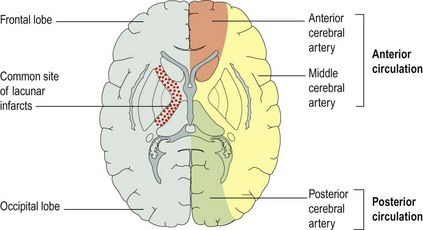Stroke III
Investigations
Investigations are directed at answering the following questions:
Is it a stroke? What kind of stroke is it?
Making the diagnosis of stroke on the basis of the history, either from the patient or a relative, and the examination is usually straightforward. The differential diagnosis that needs to be considered has been discussed previously (Box 1, p. 67). The clinical classification is considered on page 66. Haemorrhagic and ischaemic strokes cannot be reliably distinguished clinically.
The diagnosis of stroke can be confirmed by CT or MRI scanning, which will indicate whether the stroke is haemorrhagic. Early CT scans can be normal, indicating that the stroke is ischaemic and not haemorrhagic. MRI diffusion weighted images (DWI) can be used to distinguish new from old ischaemic lesions. The distribution of any abnormality will indicate the affected vascular territory (Fig. 1).
CT and MRI scans are recommended though are not yet performed in all patients.
Why did the stroke occur?
The likely aetiology of an ischaemic stroke can usually be determined from the history and examination. The range of investigations that may be used is given in Box 1.
Stay updated, free articles. Join our Telegram channel

Full access? Get Clinical Tree







